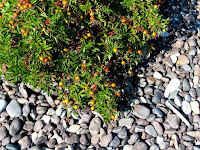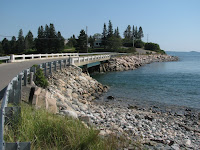





I'd only seen aerial photos of Jasper Beach before this visit, so I admit I was completely unprepared when I came to the end of the dirt road and found it blocked by a wall of gravel that extended a mile along the shoreline.
Most gravel beaches aren't really gravel beaches. They are mixed sand and gravel, sand with a surface veneer of gravel, cobble, coarse sand, and so forth. But Jasper Beach is a really a gravel beach. It looked like a training site for Maine DOT crews.
The beach face was broken into a series of berms - I'd like to call them swash terraces - and the seaward slope was incredibly steep, as might be expected on a beach with such uniform large gravel. Even with today's very gentle swell, the beach was noisy with rolling gravel.
The main lagoon (lake) is behind the eastern end of the barrier, but the berm also cut off a small valley just west of the parking area, forming a stagnant pond. The berm had been breached here in the past (recent past?), based on a big divot in the gravel ridge and small gravel overwash fan.













































